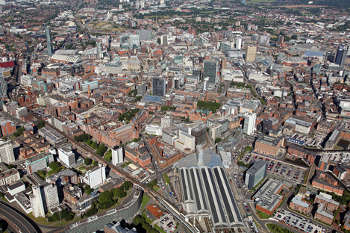Leaders from Greater Manchester’s local authorities have approved a draft spatial framework for the region, which prioritises brownfield land and seeks to link hundreds of thousands of new homes and jobs with transport infrastructure.
The Greater Manchester Spatial Framework is a joint plan by the region’s 10 local authorities for land allocation across the region over the next two decades, to accommodate 200,000 jobs and provide over 227,000 new homes.

Manchester from the air
A draft was approved at a meeting of the Joint Greater Manchester Combined Authority (GMCA)/Association of Greater Manchester Authorities (AGMA) Executive Board last week.
It has now been published and will be the subject of an eight-week consultation, with further consultation on a final draft next year.
Cllr Richard Farnell, lead member for planning and housing at GMCA, said: ‘In order to continue to attract business, workers and tourists, we need to grow. We will successfully manage this growth and deliver major economic, social and environmental improvements. We are mindful that this needs to support Greater Manchester’s prosperity in the long term as well as meet its short-term needs.’
The GMCA said the region’s local authorities are ‘working together to deliver this growth to ensure new homes and jobs are provided in the right places with the transport infrastructure (roads, rail, Metrolink) to support communities and manage growth sustainably’.
It added that a plan would allow greater control over land allocation and ensure that the development of new homes ‘comes with investment in roads, school places, green spaces and public transport’.
The framework’s section on infrastructure says that under a mayor, to be elected next year, the GMCA will ‘establish a new long-term funding mechanism for transport infrastructure to ensure timely delivery and capture of developer contributions’.
The GMCA said the framework’s ‘brownfield first’ approach to land allocation means that nearly three quarters of the proposed housing land supply will come from the existing urban area on brownfield land ‘with remaining new allocations from land being withdrawn from the greenbelt’.
Under the framework, there would also be a new greenbelt boundary for Greater Manchester.
The GMCA said the framework ‘will minimise the amount of greenbelt land required for development by focusing on relatively few, large sites. This will provide opportunities to support developments with the required transport infrastructure, necessary school places and other vital services needed to create successful neighbourhoods’.
Register now for full access
Register just once to get unrestricted, real-time coverage of the issues and challenges facing UK transport and highways engineers.
Full website content includes the latest news, exclusive commentary from leading industry figures and detailed topical analysis of the highways, transportation, environment and place-shaping sectors.
Use the link below to register your details for full, free access.
Already a registered? Login